 Afrikaans
Afrikaans  Albanian
Albanian  Amharic
Amharic  Arabic
Arabic  Armenian
Armenian  Azerbaijani
Azerbaijani  Basque
Basque  Belarusian
Belarusian  Bengali
Bengali  Bosnian
Bosnian  Bulgarian
Bulgarian  Catalan
Catalan  Cebuano
Cebuano  Corsican
Corsican  Croatian
Croatian  Czech
Czech  Danish
Danish  Dutch
Dutch  English
English  Esperanto
Esperanto  Estonian
Estonian  Finnish
Finnish  French
French  Frisian
Frisian  Galician
Galician  Georgian
Georgian  German
German  Greek
Greek  Gujarati
Gujarati  Haitian Creole
Haitian Creole  hausa
hausa  hawaiian
hawaiian  Hebrew
Hebrew  Hindi
Hindi  Miao
Miao  Hungarian
Hungarian  Icelandic
Icelandic  igbo
igbo  Indonesian
Indonesian  irish
irish  Italian
Italian  Japanese
Japanese  Javanese
Javanese  Kannada
Kannada  kazakh
kazakh  Khmer
Khmer  Rwandese
Rwandese  Korean
Korean  Kurdish
Kurdish  Kyrgyz
Kyrgyz  Lao
Lao  Latin
Latin  Latvian
Latvian  Lithuanian
Lithuanian  Luxembourgish
Luxembourgish  Macedonian
Macedonian  Malgashi
Malgashi  Malay
Malay  Malayalam
Malayalam  Maltese
Maltese  Maori
Maori  Marathi
Marathi  Mongolian
Mongolian  Myanmar
Myanmar  Nepali
Nepali  Norwegian
Norwegian  Norwegian
Norwegian  Occitan
Occitan  Pashto
Pashto  Persian
Persian  Polish
Polish  Portuguese
Portuguese  Punjabi
Punjabi  Romanian
Romanian  Russian
Russian  Samoan
Samoan  Scottish Gaelic
Scottish Gaelic  Serbian
Serbian  Sesotho
Sesotho  Shona
Shona  Sindhi
Sindhi  Sinhala
Sinhala  Slovak
Slovak  Slovenian
Slovenian  Somali
Somali  Spanish
Spanish  Sundanese
Sundanese  Swahili
Swahili  Swedish
Swedish  Tagalog
Tagalog  Tajik
Tajik  Tamil
Tamil  Tatar
Tatar  Telugu
Telugu  Thai
Thai  Turkish
Turkish  Turkmen
Turkmen  Ukrainian
Ukrainian  Urdu
Urdu  Uighur
Uighur  Uzbek
Uzbek  Vietnamese
Vietnamese  Welsh
Welsh  Bantu
Bantu  Yiddish
Yiddish  Yoruba
Yoruba  Zulu
Zulu Jan . 26, 2025 06:33
Back to list
conveyor roller parts
Belt conveyors have become fundamental components in various industry sectors due to their reliability, efficiency, and versatility. To truly appreciate their importance, one must understand the intricate parts and specific functions each part performs. This comprehensive guide delves into the components of belt conveyors, exploring their roles and underscoring the system's overall functionality.
Drive units are integral, containing the motor and gearbox that power the conveyor. These units must be matched to the conveyor's operational demands, with considerations for speed, torque, and operational efficiency. Advanced drive systems offer variable speed capabilities and energy efficiency, enhanced by incorporating smart technology features such as load sensing and automated adjustments. Conveyor belts also benefit from a diverse range of accessories, each adding functionality and value. Belt cleaners, for instance, play a crucial role in maintaining the system's endurance and productivity by removing residual materials. This minimizes the risk of belt damage and reduces maintenance needs. Skirting systems are another essential feature, preventing material spillage and ensuring product containment, which is crucial for maintaining operational efficiency and safety. Safety mechanisms are paramount in conveyor design. Emergency stop controls, safety guards, and warning systems are incorporated to protect operators and minimize the risk of accidents. Such safety features are not optional; they are mandatory for meeting regulatory compliance, especially in environments where conveyors operate continuously or transport hazardous materials. In summary, each component of a belt conveyor system plays a vital role in its operation. From the conveyor belt and pulleys to rollers, frames, and drive units, every part must be carefully chosen and expertly maintained. Understanding these parts and their functions underscores the sophistication of conveyor systems and their indispensable role in modern industry. Consequently, choosing the right configuration and maintaining it with precision can lead to enhanced productivity, reduced operational costs, and a safer working environment. As businesses increasingly rely on automation and efficiency, belt conveyors will remain key components in their operational arsenal, demanding ongoing attention to detail and expert involvement in their design and maintenance.


Drive units are integral, containing the motor and gearbox that power the conveyor. These units must be matched to the conveyor's operational demands, with considerations for speed, torque, and operational efficiency. Advanced drive systems offer variable speed capabilities and energy efficiency, enhanced by incorporating smart technology features such as load sensing and automated adjustments. Conveyor belts also benefit from a diverse range of accessories, each adding functionality and value. Belt cleaners, for instance, play a crucial role in maintaining the system's endurance and productivity by removing residual materials. This minimizes the risk of belt damage and reduces maintenance needs. Skirting systems are another essential feature, preventing material spillage and ensuring product containment, which is crucial for maintaining operational efficiency and safety. Safety mechanisms are paramount in conveyor design. Emergency stop controls, safety guards, and warning systems are incorporated to protect operators and minimize the risk of accidents. Such safety features are not optional; they are mandatory for meeting regulatory compliance, especially in environments where conveyors operate continuously or transport hazardous materials. In summary, each component of a belt conveyor system plays a vital role in its operation. From the conveyor belt and pulleys to rollers, frames, and drive units, every part must be carefully chosen and expertly maintained. Understanding these parts and their functions underscores the sophistication of conveyor systems and their indispensable role in modern industry. Consequently, choosing the right configuration and maintaining it with precision can lead to enhanced productivity, reduced operational costs, and a safer working environment. As businesses increasingly rely on automation and efficiency, belt conveyors will remain key components in their operational arsenal, demanding ongoing attention to detail and expert involvement in their design and maintenance.
Next:
Latest news
-
Revolutionizing Conveyor Reliability with Advanced Rubber Lagging PulleysNewsJul.22,2025
-
Powering Precision and Durability with Expert Manufacturers of Conveyor ComponentsNewsJul.22,2025
-
Optimizing Conveyor Systems with Advanced Conveyor AccessoriesNewsJul.22,2025
-
Maximize Conveyor Efficiency with Quality Conveyor Idler PulleysNewsJul.22,2025
-
Future-Proof Your Conveyor System with High-Performance Polyurethane RollerNewsJul.22,2025
-
Driving Efficiency Forward with Quality Idlers and RollersNewsJul.22,2025
OUR PRODUCTS





























